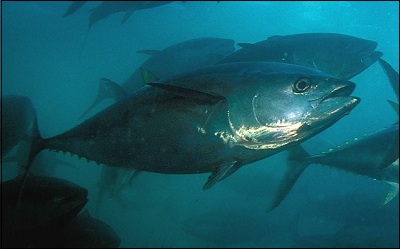
|
|

|
|
| April 25, 2024 |
|
Bluefin tuna caught off California contains radiation from Japan's Fukushima plant 
Bluefin tuna has carried radioactive contamination that leaked from Japan's crippled nuclear plant to the shores of the United States 6,000 miles away.
It is the first time a huge migrating fish has been shown to carry radioactivity such a distance. "We were frankly kind of startled," said Nicholas Fisher, one of the researchers reporting the findings online on Monday in the Proceedings of the National Academy of Sciences. The levels of radioactive caesium were 10 times higher than the amount measured in tuna off the California coast in previous years. But even so, that's still far below safe-to-eat limits set by the US and Japanese governments. Previously, smaller fish and plankton were found with elevated levels of radiation in Japanese waters after a magnitude-9 earthquake in March 2011 triggered a tsunami that badly damaged the Fukushima Daiichi reactors. But scientists did not expect the nuclear fallout to linger in huge fish that sail the world because such fish can metabolise and shed radioactive substances. One of the largest and speediest fish, Pacific bluefin tuna can grow to 10 feet (3 meters) and weigh more than 1,000 pounds (450 kilograms). They spawn off the Japan coast and swim east at breakneck speed to school in waters off California and the tip of Baja California, Mexico. Five months after the Fukushima disaster, Fisher of Stony Brook University in New York and a team decided to test Pacific bluefin that were caught off the coast of San Diego. To their surprise, tissue samples from all 15 tuna captured contained levels of two radioactive substances, ceisum-134 and caesium-137, that were higher than in previous catches. To rule out the possibility that the radiation was carried by ocean currents or deposited in the sea through the atmosphere, the team also analyzed yellowfin tuna, found in the eastern Pacific, and bluefin that migrated to Southern California before the nuclear crisis. They found no trace of caesium-134 and only background levels of caesium-137 left over from nuclear weapons testing in the 1960s. The results "are unequivocal. Fukushima was the source," said Ken Buesseler of the Woods Hole Oceanographic Institution, who had no role in the research. Bluefin tuna absorbed radioactive caesium from swimming in contaminated waters and feeding on contaminated prey such as krill and squid, the scientists said. As the predators made the journey east, they shed some of the radiation through metabolism and as they grew larger. Even so, they weren't able to completely flush out all the contamination from their system. "That's a big ocean. To swim across it and still retain these radionuclides is pretty amazing," Fisher said. Pacific bluefin tuna are prized in Japan where a thin slice of the tender red meat prepared as sushi can fetch $24 per piece at top Tokyo restaurants. Japanese consume 80 per cent of the world's Pacific and Atlantic bluefin tuna. The real test of how radioactivity affects tuna populations comes this summer when researchers planned to repeat the study with a larger number of samples. Bluefin tuna that journeyed last year were exposed to radiation for about a month. The forthcoming travellers have been swimming in radioactive waters for a longer period. How this will affect concentrations of contamination remains to be seen. Now that scientists know that bluefin tuna can transport radiation, they also want to track the movements of other migratory species including sea turtles, sharks and seabirds.(Source: The Telegraph) Story Date: May 30, 2012
|